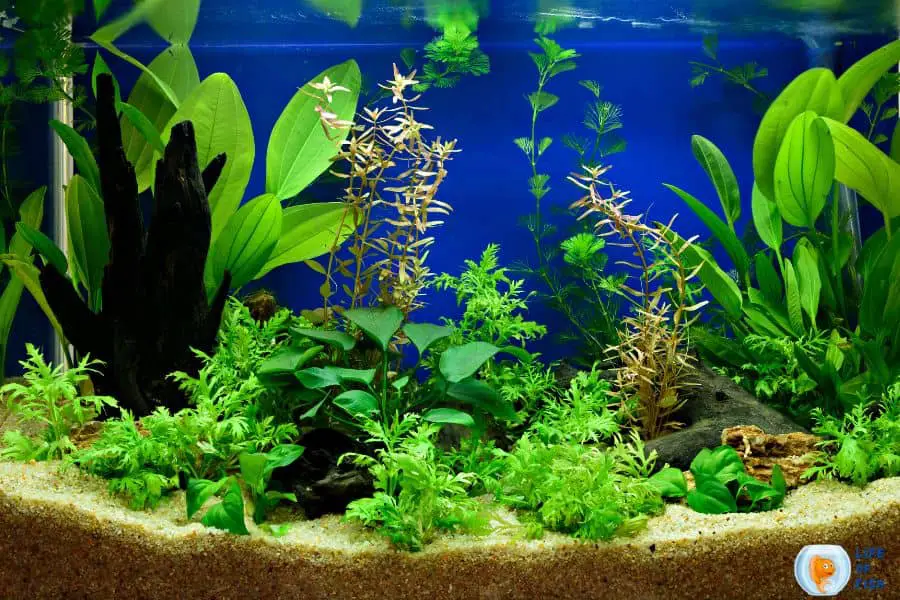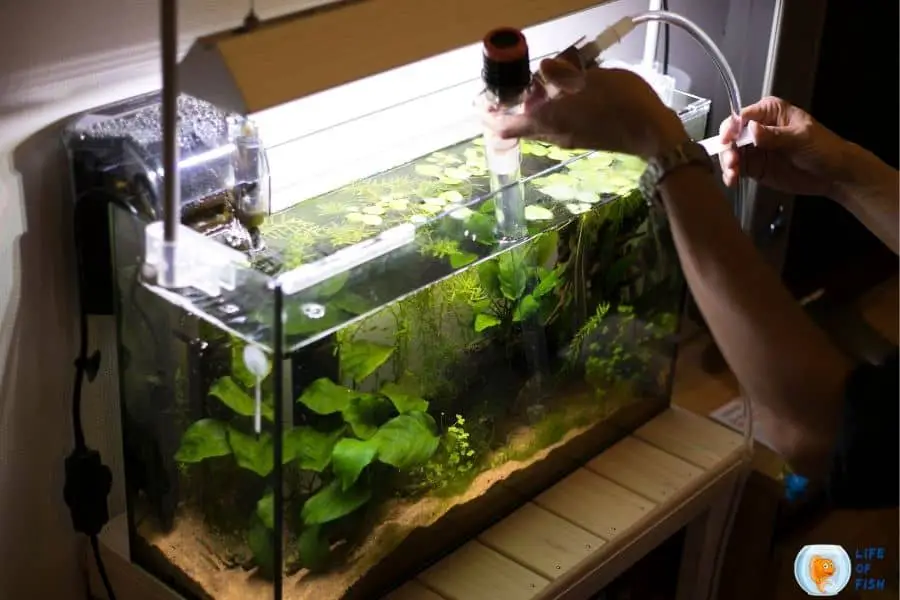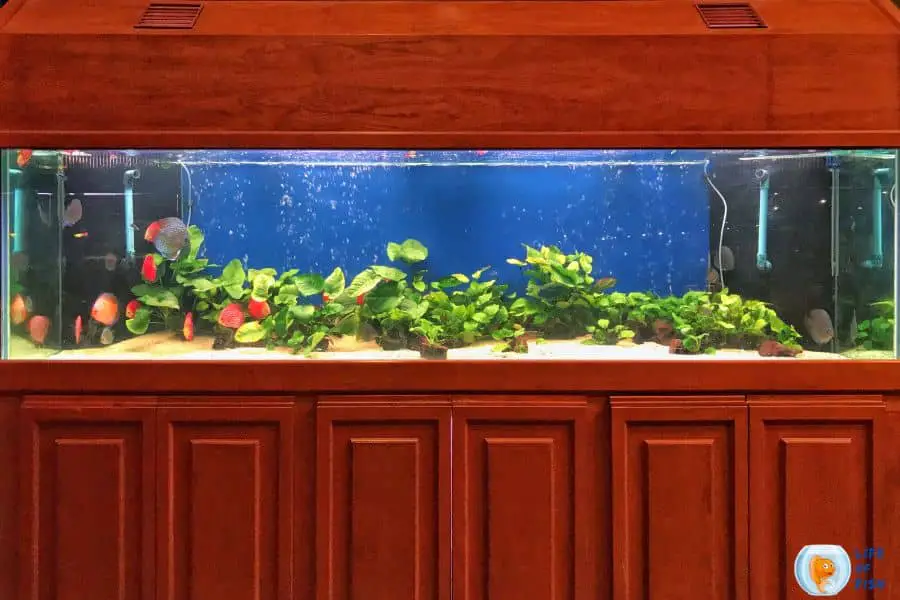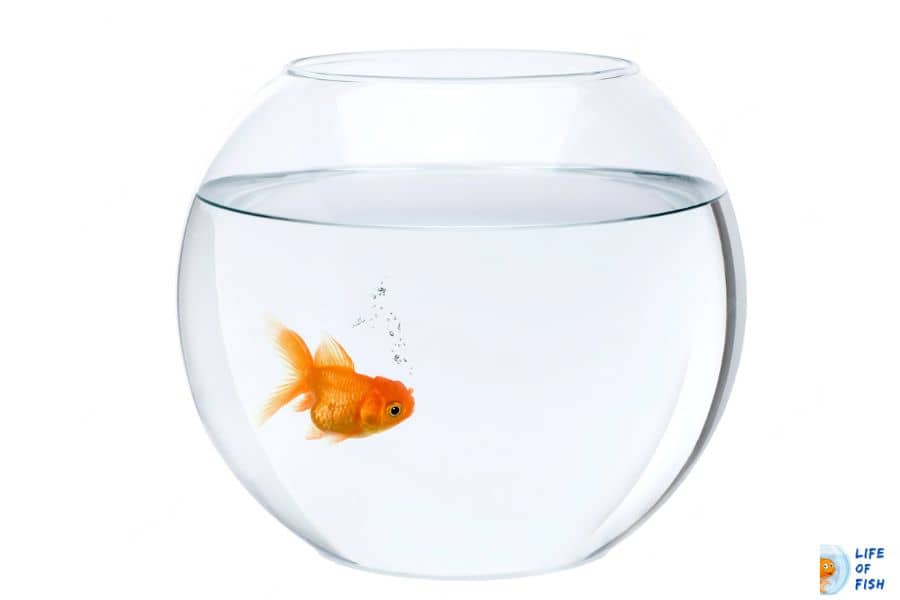Did you know that ALL aquariums must contain good bacteria to keep your fish healthy and that all new aquariums must go through a cycle before you can add fish? This is called the Nitrogen Cycle, and it is critical to the success of your aquarium.
Although there are several ways to cycle your aquarium, fishless cycling with plants is by far the best method as it is the most natural and does not put any fish at risk.
We will go through a fishless cycle with plants step by step in this article so that you can have your precious aquarium up and running as soon and safely as possible.

Why Is Cycling An Aquarium Important?
Jump To
- 1 Why Is Cycling An Aquarium Important?
- 2 Can We Add Livestock When Cycling The Aquarium?
- 3 What Are The Different Methods Of Cycling An Aquarium?
- 4 Can I Do A Fishless Cycle With Plants?
- 5 How Do You Tell If Planted Tank Is Cycled?
- 6 How Long Does It Take To Cycle A Tank With Live Plants?
- 7 When Can I Add Fish To My Tank?
- 8 Best Plants For Cycling Aquarium
- 9 How To Speed Up The Fishless Cycling
- 10 Adding fish to your aquarium too early
- 11 Cycling A Filterless Tank (How to set up filterless cycling with plants?)
- 12 Related questions
- 13 Conclusion
The Nitrogen Cycle is a process that breaks down fish waste and other organic matter into three main products: ammonia, nitrites, and nitrates.
Ammonia and nitrites are very poisonous to fish, so it is essential that these levels remain low in your aquarium.
Nitrates are not as poisonous as ammonia and nitrites, but they can still cause problems for your fish if the levels get too high.
The bacteria that live in your aquarium are responsible for breaking down these toxins. The bacteria that break down ammonia are called nitrifying bacteria, and the bacteria that break down nitrites are called denitrifying bacteria.
In a new aquarium, there are very few nitrifying bacteria present. This means that the ammonia and nitrites levels can quickly build up to toxic levels, putting your fish at risk.
This is why it is important to cycle your aquarium before adding fish.
Can We Add Livestock When Cycling The Aquarium?
You must not add any fish to your aquarium while it is cycling. The ammonia and nitrites levels will be too high for the fish to handle, and they will likely die.
If you absolutely must add any fish to your aquarium during the cycling process, you should only add a few hardy fish that can handle the high ammonia and nitrite levels. Monitor the ammonia and nitrite levels closely and remove any fish that seem to be struggling.
It is advisable to introduce fish to your aquarium once the cycle process has been completed. This will ensure that your fish are safe and healthy.

What Are The Different Methods Of Cycling An Aquarium?
There are two different methods of cycling an aquarium, but fishless cycling with plants is by far the best method. This method is the most natural and does not put any fish at risk.
Fishless Cycling With Plants
Fishless cycling with plants is the best method of cycling an aquarium. This method is the most natural and does not put any fish at risk.
Cycling the aquarium with hardy fish
If you prefer, you can cycle your aquarium with fish in it. However, this method is not recommended as it risks the fish. Still, some aquarists prefer this method as it is faster than fishless cycling.
To cycle your aquarium with fish, you will need to add a few hardy fish to your aquarium. These fish will need to be able to handle the high ammonia and nitrite levels. Monitor the ammonia and nitrite levels closely and remove any fish that seem to be struggling.
It is advisable to add extra fish to your aquarium when the cycle process is complete. This will ensure that your fish is safe and strong.
Can I Do A Fishless Cycle With Plants?
Yes. Fishless cycling with plants works by using the nitrifying bacteria already present in your aquarium to break down the ammonia and nitrites.
These bacteria live on the surfaces of your aquarium, such as on glass, gravel, and plants.
To cycle your aquarium with plants, you will need to add a few hardy plants to your aquarium. These plants will need to be able to handle the high ammonia and nitrite levels.

How Do You Tell If Planted Tank Is Cycled?
To confirm that your planted tank is cycled, add some Ammonia to your water and measure it.
After a few days, measure again to test if Ammonia levels have dropped to 0ppm; if it has, your bacteria are doing their job, and your aquarium is cycled.
Does Plant Growth Mean My Tank Is Cycled?
No. Plants help the cycling process by absorbing Ammonia, Nitrite, and Nitrate and releasing Oxygen that helps increase beneficial bacteria. However, just because your plants are growing does not mean your tank is cycled.
To confirm that your planted tank is indeed cycled, you should check the water parameters for Ammonia, Nitrite, and Nitrate. These should all be at safe levels before you add any fish to your aquarium.
Does Green Algae Mean My Tank Is Cycled?
Green algae is a common sign that a tank is nearing the end of the cycling process. This is because, as nitrates build up in the water, they provide the nutrients that algae need to thrive.
While algae blooms can be unsightly, they are generally harmless and will eventually clear up on their own when you add some algae-eating fish into your tank.
Before adding any fish to your tank, verify that it is, in fact, adequately cycled by checking the water parameters for Ammonia, Nitrite, and Nitrate. You should keep these at safe levels before adding fish to your aquarium.
How Long Does It Take To Cycle A Tank With Live Plants?
It usually takes around 4-6 weeks to cycle a tank with live plants. Although plants help speed up the cycling process, they still need time to establish themselves in your aquarium.
Once they are established, they will help to keep your water parameters at safe levels for your fish.
When Can I Add Fish To My Tank?
You can add fish to your aquarium once the ammonia and nitrite levels have dropped to 0 ppm and the nitrate levels have risen to around 20 ppm.
At this point, your aquarium is safe for fish, and the beneficial bacteria that live in your aquarium will be able to handle the waste produced by your fish.

Best Plants For Cycling Aquarium
The best plants for cycling in an aquarium are fast-growing plants that can handle high ammonia and nitrite levels. Some of the best aquarium plants for this purpose include water column feeders and root feeders.
Some water column feeders that can help with the cycling process include:
- Elodea
- Hydrilla
- Water sprite
- Duckweed
- Hornwort
- Pothos
- Water Wisteria
Root feeders that can help with the cycling process include:
- Java fern
- Anubias
- Cryptocoryne
- Bacopa
- Swords plants
How To Speed Up The Fishless Cycling
While keeping only plants is sufficient to cycle your tank, you can speed up the process by adding a source of ammonia. You can do this in several ways.
Add fish food or a pure ammonia solution.
Adding a little amount of fish food to your tank or using a pure ammonia solution will give the beneficial bacteria something to feed on, allowing them to reproduce faster and colonize your aquarium more quickly.
However, you should only add a small amount of ammonia, around one ppm. If you add too much, it could harm your plants. You can use an ammonia test kit to measure the ammonia levels in your tank.
Adding a source of ammonia will help establish the beneficial bacteria you need to cycle your tank.
However, before adding fish to your aquarium, you should wait at least two weeks. This will give the beneficial bacteria time to multiply and become established in your aquarium.
Add filter media from an already established fish tank.
Another way to speed up the cycling is by adding filter media from an already established aquarium. This will add beneficial bacteria to your tank and help speed up the cycling process.
You should only add filter media from an aquarium that is similar in size to your own, and you should ensure that the water parameters in the established aquarium are similar to the ones you are trying to achieve in your aquarium.
Adding beneficial bacteria products
This method is often used by people who are setting up a new aquarium. By adding beneficial bacteria products to your tank, you can immediately add the bacteria you need to cycle your tank.
The bacteria in these products will help establish the nitrogen cycle in your aquarium and will keep your water parameters at safe levels for your fish.
You should only add these products to your aquarium once you have added all of your live plants and made sure they are healthy and well-established.

Adding fish to your aquarium too early
One of the most common mistakes novice aquarists make while cycling their aquarium is adding fish too soon. This can be extremely toxic to your fish, even killing them.
You should only add fish to your tank once the ammonia and nitrite levels have dropped to 0 ppm and the nitrate levels have risen to around 20 ppm.
At this point, your aquarium is safe for fish, and the beneficial bacteria that live in your aquarium will be able to handle the waste produced by your fish.
Cycling A Filterless Tank (How to set up filterless cycling with plants?)
To set up filterless cycling with plants, you must gather some necessary equipment and items. These include;
- The tank
- A filter
- A heater (if required)
- Substrate
- Decorations
- Water testing kit
- Water Conditioner
- Fertilizers and
- Fresh Water
Basically, you set up an aquascape in your tank like you would in a regular fish tank. The only difference is that you don’t put any fish in the tank.
After the aquascape is complete, you fill the tank with fresh water and add the necessary chemicals like water conditioners and fertilizers.
After that, you need to wait for the plants to grow. This process can take a few weeks or more, depending on the type of plants you have in your tank.
Once the plants are fully grown, they can take in the ammonia and nitrites produced by the fishless cycling process and convert them into nitrates.
At this point, you can start adding fish to your tank. You should add a few fish at a time and monitor the water parameters closely.
If the ammonia or nitrite levels begin to rise, you can do a water change to remove the toxins from the water.
Monitoring the water parameters is essential during the fishless cycling process. You should check the ammonia, nitrite, and nitrate levels at least once weekly.
This ensures that your tank is cycling properly and that the plants can handle the waste generated by the cycling process.
Related questions
How Often Should You Do Water Changes When Cycling A Tank?
If you do fishless cycling, water change is not necessary. However, experts recommend 10 to 25% water changes every week or two to keep the tank clean and prevent the build-up of toxins.
Do Live Plants Cause Ammonia?
No, live plants do not cause ammonia. The fish and other animals produce ammonia in the aquarium as a waste product. However, if the plant rots or dies, it can release ammonia into the water.
Can You Cycle A Tank With Plants And Snails?
While adding plants during the cycling process is recommended, adding snails is unnecessary. Snails are often used to cycle a new tank because they produce a lot of waste.
However, this is not the preferable way of cycling the tank as snails die quickly, and their bodies can release toxins into the water.
It is better to cycle the tank without any animals, including snails. Once the tank is cycled, you can add a few snails to help clean up.
Can A Tank Cycle In A Week?
Yes. If you follow the proper steps recommended above, a tank can cycle in as little as one week. However, waiting at least two weeks is recommended before adding fish to the tank.
This will give the beneficial bacteria time to establish themselves in the tank and ensure that the water is safe for the fish.
Conclusion
The fishless cycling with plants process can be a bit time-consuming, but it is worth it in the end. By cycling your aquarium without fish, you can be sure that your fish will be safe and healthy. Plus, you will have a beautiful aquarium that is full of healthy plants.
Read Next : Is My Fish Choking? ( Help Is Here! )
